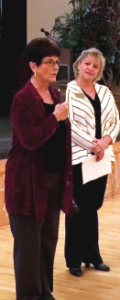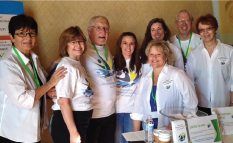 At the very heart of Parkinson & Movement Disorder Alliance (PMD Alliance) is a deep desire to meet people where they are at in their movement disorder journey. We roll up our sleeves, hold your hand and remind you that you will not walk alone.
At the very heart of Parkinson & Movement Disorder Alliance (PMD Alliance) is a deep desire to meet people where they are at in their movement disorder journey. We roll up our sleeves, hold your hand and remind you that you will not walk alone.
Whether you’re someone living with a movement disorder, or a care partner, an adult child, a friend, a doctor or a support group leader, PMD Alliance is a uniquely people-oriented community designed to care for you. We cannot do this important work alone. Together, alongside donors, corporate partners, volunteer Ambassadors, doctors and advance practice providers, the uniquely supportive PMD Alliance community provides innovative and inspiring programming and resources to those navigating a devastating diagnosis.
Because at our very core – that’s just who we are. That’s why we do this work.
In 1992, we noticed Wayne was having tremors in his right hand. We didn’t think it was anything serious, so we continued our normal, busy schedule. Wayne was an early riser and ran three miles every day! But by 1998, the tremors were more significant and were accompanied by constant fatigue. Just one year later, he was diagnosed with Parkinson disease. – Helen Squires
Helen Squires and her husband, Wayne, were married for 55 years before he died from complications due to Parkinson’s in 2016. At the time, there were limited resources for people living with Parkinson’s, let alone support for care partners and families navigating this disease with a loved one.

 TURNING STRUGGLE INTO ACTION
TURNING STRUGGLE INTO ACTION
It was watching her mother-in-law struggle to keep up with her husband’s declining health that pushed Sarah Jones, CEO and co-founder of PMD Alliance, into action.
Some memories are forever etched in our minds and hearts. I was standing on a moving walkway in the Denver Airport. My wife and I were returning from a visit with her parents. Her father’s Parkinson’s was stealing his very existence and simultaneously breaking my once fiercely energetic mother-in-law. We believed she would die before him because of the stress and strain she was experiencing in caring for her husband,” says Jones.
“As former ministers, my in-laws were active and social – rarely without people. Yet as the disease progressed, their world shrunk. They were told by doctors there was nothing more to be done. Their souls were crushed, and they were alone. And I was outraged.
Millions of dollars were pouring into research in attempt to change the future and meanwhile, no one had a service model focused on the people living with a degenerative disease today. In that moment I knew an organization needed to be created to attend to the tens of millions of people – not just patients – whose lives are impacted by Parkinson’s and other movement disorders.”
A SHARED VISION
Sarah’s vision was one that was shared with co-founder, former colleague and friend, Judy Talley who had spent the previous 15 years working in long-term and residential care settings. She and Sarah met in 2015 when working for the American Parkinson Disease Association in Tucson.
“Motivated by a deep desire to help people trying to keep their heads above water every day, PMD Alliance was born. Having run nonprofits for nearly 25 years, I was determined to create a new set of services that offered real, honest, and empathic services that moved the needle on quality of life and reduced isolation,” says Jones.
Judy Talley adds, “Sarah and I have an amazing ability to quickly and clearly communicate with each other, and together have always been aligned in our aspirations for the organization. For me, the scariest part was the most fun part. Starting something new. Developing new events and new ways to engage people. Coming up with a new paradigm to support people in their daily lives and that honors them in the entirety of their living and was about more than the disease.”
 A NEW AND UNIQUE SPACE
A NEW AND UNIQUE SPACE
One of the “new” things that PMD Alliance has introduced to the movement disorder space is its unique Movement Disorder Care and Support Ecosystem© which focuses on strengthening all persons affected by a diagnosis. When everyone involved is better educated, better supported and more connected, the person with the movement disorder has more opportunities to live more fully.
At PMD Alliance, that translates into support groups for care partners, a Facebook group for adult children, a unique catalog of programming that focuses on everything from physical activity to medication options to end of life care. Just ?ve years since its start, as the organization continues to grow and serve people not only nationally but internationally, PMD Alliance still strives to meet people where they are at in their journey and to ?ll needs when they are seen.
 I am amazed how strong people with the disease can be; accepting, resisting, and adapting as they cope through the years. – Judy Talley, Co-Founder PMD Alliance
I am amazed how strong people with the disease can be; accepting, resisting, and adapting as they cope through the years. – Judy Talley, Co-Founder PMD Alliance
The reality is there are 40 million Americans living with movement disorders. 40 million. While there is still no cure for Parkinson’s disease, with PMD Alliance there is hope. There is partnership. There is community. And there remains a deep desire shared among everyone involved in the community to touch the lives of many.
Oftentimes among its staff, PMD Alliance asks each other – “what is our ‘why’?”
It’s a good reminder to check-in. To make sure the programs and resources offered meet a need. To search for unmet needs and to innovate. To remember why it is that this work is so important not only to people living with movement disorders, but for those who care about them.
When we do that, we are reminded of Helen Squires and why PMD Alliance was started in the first place. We are all trying to navigate and live our very best lives despite this devastating disease, and if we work together, we have a better chance at doing just that.
Will you join us? 
About the Author: Sarah Jones, MPA, MS Strategic Design, CEO. With more than 25 years of experience leading non-profits and healthcare programs, Sarah is a visionary leader. As a dyed-in-the-wool dynamo who continually seeks opportunities to impact and address unmet needs, Sarah has designed programs and led training for local, national and international audiences, including groups in Canada and Botswana. Called upon to solve issues of efficiency and develop a culture of innovation, she has also acted as a consultant for global brands, including Campbell’s Soup. Sarah holds two master’s degrees: Master of Science in Strategic Design Management and Master in Public Administration. She has consulted with large health care systems, integrative medicine clinics teaching utilization of strategic design principles to innovate and change end-user experience. Sarah is driven to create a world that people are excited to live in.